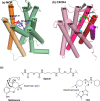Bivalent Ligand Aiming Putative Mu Opioid Receptor and Chemokine Receptor CXCR4 Dimers in Opioid Enhanced HIV-1 Entry
- PMID: 33214847
- PMCID: PMC7667867
- DOI: 10.1021/acsmedchemlett.0c00444
Bivalent Ligand Aiming Putative Mu Opioid Receptor and Chemokine Receptor CXCR4 Dimers in Opioid Enhanced HIV-1 Entry
Abstract
A bivalent compound 1a featuring both a mu opioid receptor (MOR) and a CXCR4 antagonist pharmacophore (naltrexone and IT1t) was designed and synthesized. Further binding and functional studies demonstrated 1a acting as a MOR and a CXCR4 dual antagonist with reasonable binding affinities at both receptors. Furthermore, compound 1a seemed more effective than a combination of IT1t and naltrexone in inhibiting HIV entry at the presence of morphine. Additional molecular modeling results suggested that 1a may bind with the putative MOR-CXCR4 heterodimer to induce its anti-HIV activity. Collectively, bivalent ligand 1a may serve as a promising lead to develop chemical probes targeting the putative MOR-CXCR4 heterodimer in comprehending opioid exacerbated HIV-1 invasion.
Conflict of interest statement
The authors declare no competing financial interest.
Figures





Similar articles
-
Design and synthesis of a bivalent probe targeting the putative mu opioid receptor and chemokine receptor CXCR4 heterodimer.RSC Med Chem. 2019 Dec 19;11(1):125-131. doi: 10.1039/c9md00433e. eCollection 2020 Jan 1. RSC Med Chem. 2019. PMID: 33479612 Free PMC article.
-
Novel bivalent ligands carrying potential antinociceptive effects by targeting putative mu opioid receptor and chemokine receptor CXCR4 heterodimers.Bioorg Chem. 2022 Mar;120:105641. doi: 10.1016/j.bioorg.2022.105641. Epub 2022 Jan 24. Bioorg Chem. 2022. PMID: 35093692 Free PMC article.
-
A Bivalent Ligand Targeting the Putative Mu Opioid Receptor and Chemokine Receptor CCR5 Heterodimers: Binding Affinity versus Functional Activities.Medchemcomm. 2013 May 1;4(5):847-851. doi: 10.1039/C3MD00080J. Medchemcomm. 2013. PMID: 23682308 Free PMC article.
-
Ligand-Free Signaling of G-Protein-Coupled Receptors: Relevance to μ Opioid Receptors in Analgesia and Addiction.Molecules. 2022 Sep 8;27(18):5826. doi: 10.3390/molecules27185826. Molecules. 2022. PMID: 36144565 Free PMC article. Review.
-
Bivalent ligands targeting chemokine receptor dimerization: molecular design and functional studies.Curr Top Med Chem. 2014;14(13):1606-18. doi: 10.2174/1568026614666140827144752. Curr Top Med Chem. 2014. PMID: 25159160 Free PMC article. Review.
Cited by
-
Neurological impact of HIV/AIDS and substance use alters brain function and structure.Front Med (Lausanne). 2025 Jan 7;11:1505440. doi: 10.3389/fmed.2024.1505440. eCollection 2024. Front Med (Lausanne). 2025. PMID: 39839621 Free PMC article. Review.
-
Drugs of Abuse and Their Impact on Viral Pathogenesis.Viruses. 2021 Nov 29;13(12):2387. doi: 10.3390/v13122387. Viruses. 2021. PMID: 34960656 Free PMC article. Review.
-
Structure-Based Design and Development of Chemical Probes Targeting Putative MOR-CCR5 Heterodimers to Inhibit Opioid Exacerbated HIV-1 Infectivity.J Med Chem. 2021 Jun 10;64(11):7702-7723. doi: 10.1021/acs.jmedchem.1c00408. Epub 2021 May 23. J Med Chem. 2021. PMID: 34027668 Free PMC article.
-
Beyond the Syndemic of Opioid Use Disorders and HIV: The Impact of Opioids on Viral Reservoirs.Viruses. 2023 Aug 9;15(8):1712. doi: 10.3390/v15081712. Viruses. 2023. PMID: 37632053 Free PMC article. Review.
-
The synthetic opioid fentanyl increases HIV replication and chemokine co-receptor expression in vitro.J Neurovirol. 2022 Dec;28(4-6):583-594. doi: 10.1007/s13365-022-01090-3. Epub 2022 Aug 17. J Neurovirol. 2022. PMID: 35976538 Free PMC article.
References
LinkOut - more resources
Full Text Sources
Chemical Information
Research Materials

